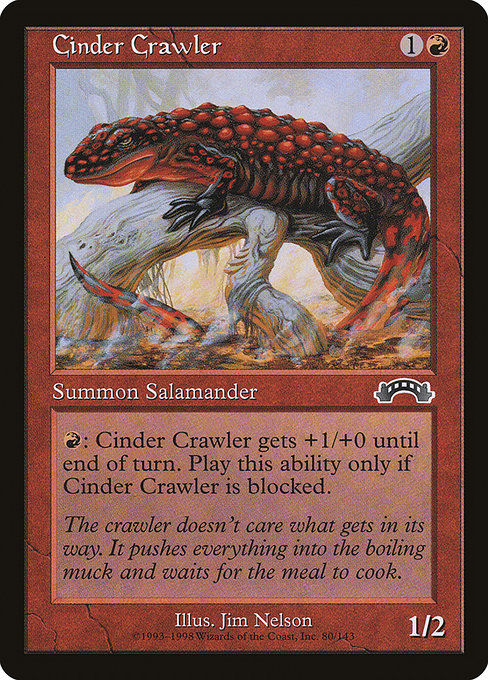
Image courtesy of Scryfall.com
When Red Gets Drafted into the Block: How Cinder Crawler Quietly Upset MTG Design Norms
If you were rummaging through Exodus packs in the late 1990s, you might have reached for red with a shrug, expecting the usual bite: direct burn, quick creatures, or flashy tempers. Cinder Crawler came along and quietly flipped the script. This common red Salamander for two mana wears a subtler hat than most red cards of its era: a body that’s perfectly serviceable at 1/2, and an activated ability that only shows up when the creature is blocked. It’s small, it’s hot, and it’s oddly exacting in its design. 🧙♂️🔥💎
The card foregrounds two deceptively simple ideas: a low-cost creature that can actually threaten a trade, and a trigger that rewards a very specific combat outcome. Its mana cost is {1}{R}, a clean signal that this is a red card built for tempo and pressure rather than big stomps. The body—1 power, 2 toughness—suggests a trader rather than a tank, a creature designed to entice a block and then punish the defender with a timely buff. The actual text, "{R}: This creature gets +1/+0 until end of turn. Activate only if this creature is blocked," reads like a challenge to both players: pick your blocks carefully, or risk turning a modest 1/2 into a surprisingly sturdy 2/2 for a single swing. ⚔️
This is where the design norms begin to bend. Red in MTG has long carried the burden of aggression and direct damage, a lineage of lightning-quick plays that press for speed and direct impact. Cinder Crawler, however, locals its strength into the moment of contact. The buff is conditional, temporary, and situational—precisely the kind of mechanic that rewards careful combat math rather than a straight line of increments. It’s not a burn spell you cast on the opponent; it’s a calculated risk you take mid-battle, hoping to turn a trading block into a favorable outcome for the rest of the turn. The design choice resonates with the chaotic, boiling-muck flavor the set’s flavor text invokes. 🔥🧙♂️
The crawler doesn't care what gets in its way. It pushes everything into the boiling muck and waits for the meal to cook.
In Exodus, a set famous for its era-defining (and sometimes polarizing) mechanics, Cinder Crawler stands as a case study in micro-design bravery. It’s a common card, not a mythic or a rare, so its audacity doesn’t come with a bank-breaking price tag or a showy ability that steals the spotlight. Yet its presence challenges players to rethink how a two-mana creature can contribute to the tempo game. It invites a defender to consider not just whether to block, but what the block says about your opponent’s timing and risk tolerance. And when the buff lands, the little Salamander can force a surprising swing that might end up winning a race you hadn’t fully anticipated. 🎲🎨
Artwork often carries its own message about design intent, and Jim Nelson’s depiction of Cinder Crawler helps sell that risk-versus-reward feel. The creature plows forward through a boiling, chaotic landscape, its embers echoing the red mana of its spells. The flavor text locks the creature’s identity into a predatory, almost industrial image: a patient crawler waiting for the moment to collide with a meal. It’s a thoughtful synthesis of form and function—art that echoes the card’s mechanical curiosity and a mechanical idea that rewards careful, counterintuitive play. 🧩
From a broader design-history vantage point, Cinder Crawler helps illustrate how early MTG designers were willing to experiment within red’s identity. The mechanic doesn’t rely on sinuous words or a flashy tap/untap engine; it uses a straightforward trigger that relies on a very human part of the game: choosing to block. That choice can be the difference between a clean trade and a surprising swing for the red deck, one that can catch an overconfident blocker unprepared. It’s a reminder that not every memorable design needs to shout; sometimes it whispers, “Look closer at the block, and you’ll see the spark.” 🧙♂️⚔️
For collectors and historians, Cinder Crawler is a delightful artifact. It’s a low-cost, low-foil investment with a distinctive design that still prompts conversation today about how red’s toolkit has evolved across eras. The rarity is common, the power level is modest, but the thoughtfulness behind its constraint remains a talking point for players who love the subtle deductions of combat math. If you’re building a historical red deck from Exodus or simply chasing proof that MTG’s early days supported design play rather than pure numbers, this little Salamander offers a compact piece of the conversation. 💎🎲
Rugged Phone Case — Tough Impact-Resistant ShieldMore from our network
- https://wiki.digital-vault.xyz/wiki/post/pokemon-tcg-stats-duskull-card-id-ex14-51/
- https://wiki.digital-vault.xyz/wiki/post/pokemon-tcg-stats-ionos-bellibolt-ex-card-id-sv09-172/
- https://wiki.digital-vault.xyz/wiki/post/pokemon-tcg-stats-elekid-card-id-ex10-23/
- https://crypto-acolytes.xyz/blog/post/nft-stats-l904-six-wheels-from-haste-motion-collection/
- https://blog.crypto-articles.xyz/blog/post/nft-data-nuddies-1603-from-nuddies-collection-on-magiceden/

Cinder Crawler
{R}: This creature gets +1/+0 until end of turn. Activate only if this creature is blocked.
ID: a9406050-d76b-4569-a463-e21acaf84166
Oracle ID: 3850479f-1c1e-4a72-ae47-6da2997202e2
Multiverse IDs: 6105
TCGPlayer ID: 4302
Cardmarket ID: 9308
Colors: R
Color Identity: R
Keywords:
Rarity: Common
Released: 1998-06-15
Artist: Jim Nelson
Frame: 1997
Border: black
EDHRec Rank: 30101
Set: Exodus (exo)
Collector #: 80
Legalities
- Standard — not_legal
- Future — not_legal
- Historic — not_legal
- Timeless — not_legal
- Gladiator — not_legal
- Pioneer — not_legal
- Modern — not_legal
- Legacy — legal
- Pauper — legal
- Vintage — legal
- Penny — legal
- Commander — legal
- Oathbreaker — legal
- Standardbrawl — not_legal
- Brawl — not_legal
- Alchemy — not_legal
- Paupercommander — legal
- Duel — legal
- Oldschool — not_legal
- Premodern — legal
- Predh — legal
Prices
- USD: 0.10
- EUR: 0.07
- TIX: 0.09
More from our network
- https://crypto-articles.xyz/tmpj50v7gfk/dawm-diffusion-action-world-models-for-offline-rl-via-action-inferred-transitions.html
- https://wiki.digital-vault.xyz/wiki/post/pokemon-tcg-stats-jigglypuff-card-id-sm4-71/
- https://wiki.digital-vault.xyz/wiki/post/pokemon-tcg-stats-wooper-card-id-sma-sv9/
- https://transparent-paper.shop/blog/post/dr3-precision-illuminates-a-ten-solar-radii-blue-star-at-24-kpc/
- https://crypto-acolytes.xyz/blog/post/nft-stats-children-of-cope-405-from-children-of-cope-collection/
